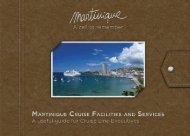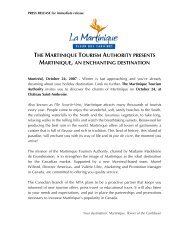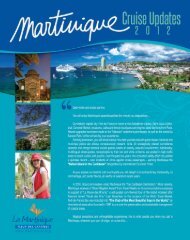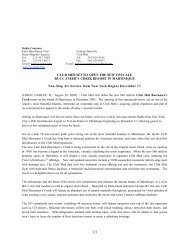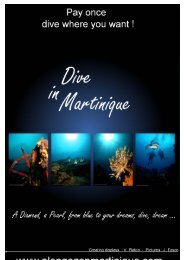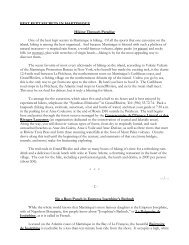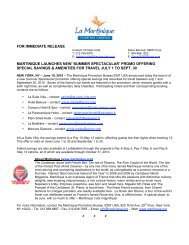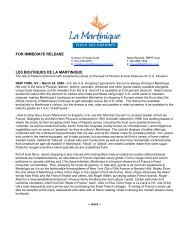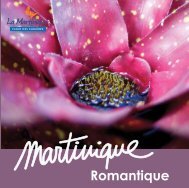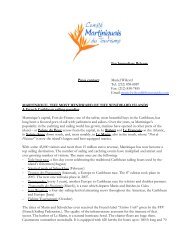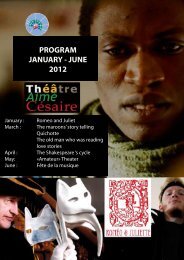sales guide martinique
sales guide martinique
sales guide martinique
Create successful ePaper yourself
Turn your PDF publications into a flip-book with our unique Google optimized e-Paper software.
to the public by a foundation devoted to exploring<br />
the link between rum and Martinican culture.The<br />
Maison Créole, the restored 18th-century residence<br />
on the property, is beautifully appointed and has been<br />
classified as a historic monument.<br />
Fifteen miles from Fort-de-France.<br />
Tourist Information Bureau<br />
Tel./Fax : 0596 54 67 50<br />
Great Escapes<br />
THE BOTANICAL NORTH : FORT-DE-FRANCE -<br />
PRÊCHEUR<br />
The Route de la Trace is truely a botanical trail,<br />
bordered with heliconia flowers and bracken fern,<br />
taking you into deep into the tropical splendor of the<br />
Martinican rainforest. The trail winds through thick<br />
vegetation, and over tumultuous mountain streams,<br />
all the way to Mount Pelée.<br />
Balata Church is a miniature replica of the Basilica of<br />
Montmartre in Paris. It was built in 1924, and offers a<br />
panoramic view of Fort-de-France and its bay.<br />
Experience a bit of Paradise in the Balata Garden,<br />
where you can stroll among groves and flowerbeds<br />
planted with a multitude of tropical species.<br />
Take a break with a refreshing dip in the Alma River.<br />
The pictoresque village of Fonds Saint-Denis is<br />
decked with flowers, and it faces Mount Pelée.<br />
Saint-Pierre, the « little Paris of the Antilles, » was<br />
erased from the face of the Earth in three minutes<br />
by an eruption of Mount Pelée. In 1990 it was<br />
classified as a City of Art and History. Stroll through<br />
the ruins and visit the Franck Perret Museum of<br />
Volcanology, established in 1932 by Perret, himself a<br />
volcanologist.<br />
At this point you have a choice: You could<br />
continue north along the coast to Le Prêcheur<br />
or you could continue inland, northeast toward<br />
Morne-Rouge and eventually to the Atlantic<br />
coast.<br />
If you take the route to Le Prêcheur, you will<br />
discover the town’s superb beach at Anse Céron,<br />
with its lovely alley lined with coconut palm trees<br />
beneath the ruins of Habitation Céron. From Le<br />
Prêcheur, you can embark on an exceptional six-hour<br />
hike taking you to Grand-Rivière, on the Atlantic<br />
coast at the extreme northern end of the island.<br />
The route through the town of Morne-Rouge will<br />
take you to Aileron, a point of departure for climbs<br />
up Mount Pelée, where you can command views of<br />
Martinique from one coast to the other.<br />
THE CARIBBEAN NORTH<br />
A succession of small inlets shelter pictoresque<br />
fishing villages, where fisherman practice the<br />
traditional pêche à la senne, fishing with nets. All the<br />
while they’re engaging in singing and conversation,<br />
which you’re welcome to join if the spirit moves you.<br />
In Case-Pilote, you’ll find the oldest church on the<br />
island, dating to the 17th century.<br />
The Canton Suisse, a community in Morne-Vert,<br />
has a rather evocative name. With reason! You’ll<br />
understand why when you note the dramatic change<br />
to steep alpine scenery.<br />
In Le Carbet, you’ll find the Paul Gauguin Museum<br />
not far from the spot where the famous painter stayed<br />
for five months in 1887, with his friend Charles Laval.<br />
THE ATLANTIC NORTH<br />
The magnificent bay at Le Robert is dotted with lots<br />
of islets and coral reefs. It’s a much sought-after<br />
haven for sailors.<br />
Just beyond Trinité is the fishing village Tartane on<br />
the Caravelle Peninsula. The peninsula is embued<br />
with the history of the Dubuc family, and here you’ll<br />
find the ruins of the Château Dubuc, set within the<br />
Caravelle Natural Reserve. The reserve also offers<br />
some beautiful hiking trails.<br />
From Sainte-Marie, take a detour to Morne des<br />
Esses to admire the craftsmanship at the basketry<br />
workshop there, visit the Rum Museum at the Saint<br />
James Distillery, and the Habitation Fonds Saint-<br />
Jacques. Ride on a small train through sugarcane<br />
fields, a visual demonstration of the importance of a<br />
crop that was—and still is—a major source of wealth<br />
for Martinique. Stop by the Banana Museum. And<br />
don’t forget to take a stroll on the tombolo. From<br />
November to April, this sandbar connects the town<br />
of Sainte-Marie to the adjacent Sainte-Marie Islet, a<br />
natural curiosity caused by the tides.<br />
In Basse-Pointe, visit Habitation Pécoul, built in<br />
the 18th century and now classified as a historic<br />
monument. There’s also the Leyritz Plantation, with<br />
its Museum of Plant Figurines.<br />
In Macouba, children engage in a spectacular sport<br />
: Like novice sailors, they brave the choppy Atlantic<br />
waters, floating on tree trunks<br />
called flots.<br />
48



